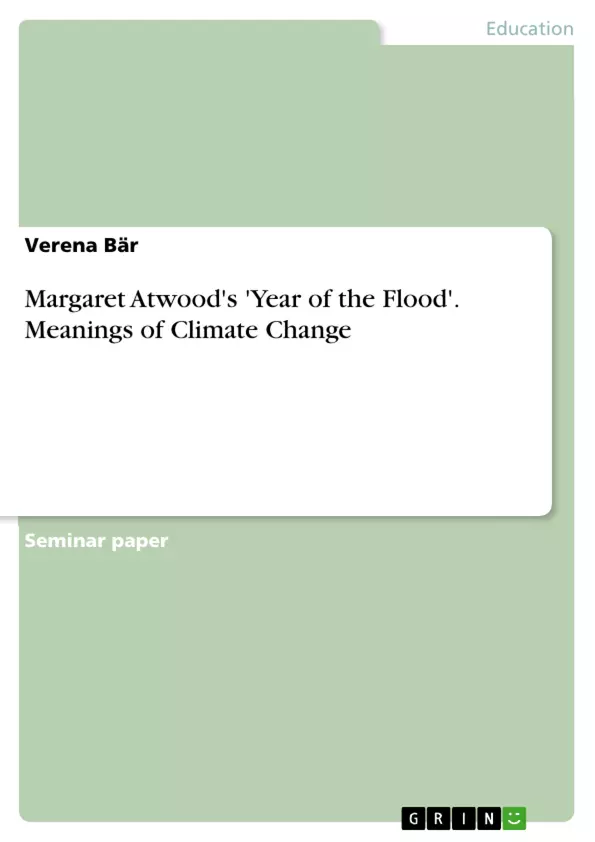In her book The Year of the Flood (YOF) the Canadian author Margaret Atwood gives us an insight in how our future might look like and this foresight is not so unthinkable at all. The novel is placed in what is today the United States of America, probably somewhere on the East Coast. The time it is set in a not so far away future where the Apocalypse had already occurred. The plot is situated around the two main characters Toby and Ren who give us insights into the pre-apocalyptic time throughout the book. The environment which is portrayed is disturbed in many ways: the effects of a global climate change are apparent; society has split up into different groups. YOF is centered in the pleeblands where the lower social classes are situated. The picture of the society we get is that it is in an ‘unhealthy condition’. It has mainly lost its ethics and moral and there is an increased willingness of violence not only by individuals but also by the leading CorpSeCorps forces, a private security firm. Eventually, the whole human race is extinguished by a pandemic and only a few survive. Next to Toby and Ren, the survivors mainly consist of the members of eco-activist groups. Now, they have to face the question of survival and have to deal with a new species of ‘man’ – the Crakers.
Inhaltsverzeichnis (Table of Contents)
- Introduction
- Climate Change in Literature
- Meanings of Climate Change in Margaret Atwood's Year of the Flood
- Climate Change – the Physical Effects
- Climate Change and Society
- The question of responsibility
- The question of ethics and moral
- Climate change and women
- Climate Change and the Waterless Flood
- Conclusion
Zielsetzung und Themenschwerpunkte (Objectives and Key Themes)
This essay aims to analyze the various impacts of climate change on different aspects of life in Margaret Atwood's Year of the Flood. The primary focus is on understanding the meanings climate change holds within the novel's narrative. By examining the physical effects of climate change, exploring the social consequences, and analyzing how the novel portrays responsibility, ethics, and the connection between climate change and women, the essay seeks to shed light on Atwood's commentary on the complex relationship between humanity and the environment.
- The physical effects of climate change on the world portrayed in Year of the Flood
- The social and ethical consequences of climate change in the novel
- The role of climate change in shaping the societal structures and dynamics within the narrative
- Atwood's portrayal of the interconnectedness of human actions and their impact on the environment
- The novel's potential to serve as a warning about the dangers of climate change and unsustainable practices
Zusammenfassung der Kapitel (Chapter Summaries)
The essay begins by introducing the premise of Year of the Flood, highlighting the apocalyptic setting and the novel's focus on the aftermath of climate change. It establishes the novel's relevance as a commentary on contemporary societal concerns. Chapter 2 explores the broader context of climate change in literature, acknowledging its growing presence as a literary genre and highlighting the novel's unique engagement with the topic. Chapter 3 delves into the specific meanings of climate change in Year of the Flood, starting with an examination of the physical changes in the novel's world. This section explores the effects of higher radiation, increased evaporation, warming seas, and extreme weather events, highlighting the extent to which the novel reflects contemporary concerns about climate change.
Schlüsselwörter (Keywords)
The main keywords and focus topics of the text include climate change, environmentalism, dystopia, social responsibility, ethics, gender, and environmental justice. The essay explores the various meanings of climate change within the novel, analyzing its impact on the physical environment, social structures, and ethical considerations. The themes of responsibility, ethics, and gender are explored in the context of the novel's depiction of societal responses to the consequences of climate change.
- Quote paper
- Verena Bär (Author), 2012, Margaret Atwood's 'Year of the Flood'. Meanings of Climate Change, Munich, GRIN Verlag, https://www.grin.com/document/230146



